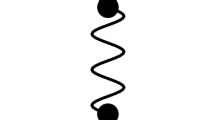Abstract
Traditional lore holds that there is only one way to represent local symmetry, leading to practically unique gauge theories. However there is more than one path to local symmetry. Here I discuss expressing the theory of dressed quarks, gluons and other particles using new variables. The gauge sector is expressed with fields ea μ which transform homogeneously like matter fields under the gauge group. Consistency requires further embedding in a larger global group. Many interesting topics of gauge theories, from the elementary nature of the Coulomb field to magnetic monopoles, serve as illustrations. Geometrical invariants forbidden in the standard coordinates become available in the new approach. I argue that these are natural, and useful, in the description of an effective theory. For example, in a covariant derivative expansion, one can express a massively propagating gauge invariant effective theory in four space-time dimensions.
Similar content being viewed by others
REFERENCES
James MacCullagh, “An Essay Towards a Dynamical Theory of Crystalline Reflexion,” Proceedings of the Royal Irish Academy 1, 374(1836–1840); also published in Philosophical Magazine, Ser. 3, 16 (1840). See also the Collected Works of James MacCullagh, John Jewett and Samuel Haughton, eds. (Trinity College, Dublin, 1881).
William Thomson (Lord Kelvin), Baltimore Lectures (1884).
P. A. M. Dirac, The Physical Principles of Quantum Mechanics, 3rd edn. (Cambridge University Press, 1958).
M. Lavelle and D. McMullan, Physics Reports 279, 1 (1997) and references therein. E. Bagan, M. Lavelle, and D. McMullan, Phys. Rev. D 57, 4521 (1998); Mod. Phys. Lett. A 12, 1815 (1997); Erratum-ibid. A 12, 2317 (1997).
M. Belloni, L.-S. Chen, and K. Haller, Phys. Lett. B 403, 316 (1997); Phys. Lett. B 373, 185 (1996). K. Haller and L.-S. Chen, in 29th International Conference on High-Energy Physics (ICHEP 98)(Vancouver, Canada, 1998), to be published, hep-th-9808044; see also hep-th/9803250.
J. P. Ralston, preprint (1997, 1999); R. Buniy and J. P. Ralston, in preparation.
P. E. Haagensen, K. Johnson, and C. S. Lam, Nucl. Phys. B 477, 273 (1996). K. Johnson, in Quantum Infrared Physics (Paris, 1996), H. Fried and B. Muller, eds. (World Scientific, 1997).
See elementary texts on Differential Geometry. Especially good is the book by D. Stoker, Differential Geometry (Wiley, 1965). See also Differential Geometry by H. W. Guggenheimer (McGraw-Hill, 1963).
H. Frenkel,The Geometry of Physics (Wiley, 1997).
G. 't Hooft, Nucl. Phys. B 190, 455 (1971). J. Arafune, P. G. O. Freund, and C. Goebel, J. Math. Phys 16, 433 (1975).
Author information
Authors and Affiliations
Rights and permissions
About this article
Cite this article
Ralston, J.P. Embedding Coordinates for the Well-Dressed Quark. Foundations of Physics 30, 493–518 (2000). https://doi.org/10.1023/A:1003678210280
Issue Date:
DOI: https://doi.org/10.1023/A:1003678210280



